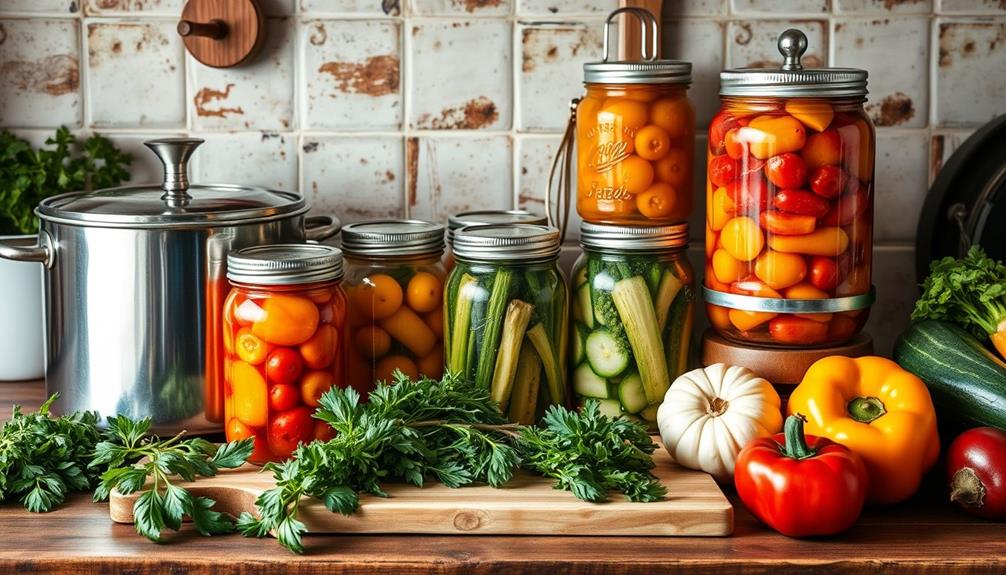You're preparing for the unexpected and want to know the essential items from 2015 that still matter today. Start with food and water essentials like canned goods, dried fruits, and bottled water – at least a gallon per person per day. Next, gather survival gear and tools like flashlights, multi-tools, and portable water filters. Don't forget communication and navigation tools like battery-powered radios and local maps. Make sure you have shelter and clothing needs like tents, sleeping bags, and weather-appropriate attire. Finally, pack health and hygiene must-haves like first aid kits, hygiene products, and prescription medications. You're just getting started – there's more to learn to secure your survival and comfort.
Key Takeaways
- Stockpile non-perishable food items like canned goods, rice, and dried fruits for extended survival.
- Ensure a reliable water supply with at least one gallon per person per day for drinking, cooking, and hygiene.
- Pack essential tools like flashlights, multi-tools, and portable water filters for emergency situations.
- Include a first aid kit, prescription medications, and hygiene products like toilet paper and soap in your prep list.
- Store communication devices like battery-powered radios, whistles, and signal mirrors for staying informed and signaling for help.
Food and Water Essentials
When building your emergency stash, prioritize food and water essentials that will sustain you and your loved ones for an extended period, as these basics are important for survival.
In 2015, preppers knew that stockpiling non-perishable items like canned goods, rice, and dried fruits was a necessity for long-term storage. Don't forget to include non-perishable snacks that'll provide energy during crises.
In the face of natural disasters, having a reliable water supply is critical. Bottled water should be a top priority to guarantee hydration and survival. Aim to store at least one gallon per person per day for drinking, cooking, and hygiene. Remember, access to clean water can be limited during emergencies, so it's crucial to be prepared.
While gathering food and water essentials, don't overlook the importance of first aid supplies. A well-stocked first aid kit can help address minor injuries and prevent more severe conditions.
Survival Gear and Tools

Having stocked up on food and water, it's time to focus on the survival gear and tools that'll help you navigate the challenges of an emergency situation.
You'll need essential items like flashlights, multi-tools, and portable water filters to guarantee your basic needs are met. Communication tools like battery-powered radios, whistles, and signal mirrors will help you stay connected with the outside world.
When it comes to shelter, having a tent, sleeping bag, and portable stove will provide you with a sense of safety and comfort. Don't forget tools like duct tape, ropes, and axes, which will come in handy for building shelters and creating fire.
Communication and Navigation

Your ability to communicate and navigate effectively can mean the difference between life and death in a survival situation. When disaster strikes, you'll need reliable tools to stay informed, find your way, and signal for help.
That's why a battery-powered radio is a must-have in your prepper's list. It'll keep you updated on the situation even when the power's out.
For navigation, local maps are essential. They'll help you find routes and resources in unfamiliar or disrupted areas. But what if you're lost or need to signal for help?
A signal mirror can reflect sunlight towards any potential rescuers during the day, while a whistle can produce a loud, piercing sound to attract attention.
In case you need to leave a message, don't forget to pack paper and pen. These simple tools can aid in leaving notes or messages for others when electronic communication is unavailable.
Shelter and Clothing Needs

You'll need reliable shelter and clothing to protect yourself from the elements and maintain a sense of comfort and safety in the face of disaster. Having the right gear can make all the difference in an emergency situation.
When it comes to shelter, don't forget these essentials:
- Tents and tarps: Provide a dry and windproof space to call your own.
- Sleeping bags and blankets: Keep you warm and cozy in cold weather.
- Portable stoves and matches: Allow you to cook hot meals and stay warm.
- Plastic sheeting: Offers an extra layer of protection from the elements.
In addition to shelter, clothing needs are also important. Pack weather-appropriate attire, extra socks, boots, gloves, and rain ponchos to ensure you're prepared for any situation.
Health and Hygiene Must-Haves

As you stockpile shelter and clothing, don't overlook the vital role health and hygiene play in your survival, and make sure to pack these must-haves to maintain physical and emotional well-being.
Medical essentials should be at the top of your list. A first aid kit is a no-brainer, but don't forget to include prescription medications, pain relievers, vitamins, and a thermometer. These items will help you treat injuries and illnesses, and prevent the spread of infection.
Hygiene products are often overlooked, but they're essential for maintaining health in emergency situations. Make sure to pack toilet paper, soap, toothbrush, feminine hygiene products, and towels. These items may seem minor, but they'll help prevent the spread of disease and keep you feeling fresh and clean.
Frequently Asked Questions
What Does Every Prepper Need?
'You need a well-stocked emergency kit with essentials like food, first aid supplies, survival gear, communication tools, hygiene products, and shelter supplies to guarantee your safety and comfort during unexpected disasters or crises.'
What Do Preppers Stock up On?
What do you stock up on as a prepper? You stock up on essentials like food, medical supplies, communication tools, hygiene products, shelter supplies, and self-defense items to guarantee survival and comfort during emergencies.
What Is the Best Food to Stockpile Long Term?
When stockpiling food, prioritize non-perishable items like canned goods, rice, dried fruits, and nuts, which are rich in nutrients and have a long shelf life, ensuring you're prepared for any emergency.
What Are the Top 10 Survival Foods?
When it comes to survival, you'll want to stock up on the top 10 essentials: canned goods, rice, grains, dried fruits and nuts, non-perishable snacks, and bottled water to sustain you during emergencies.
What Items From the Past Are Still Essential for Survival Today?
In the world of survivalism, the ultimate preppers list: musthave items from the past still hold their value today. Items like fire starters, hunting tools, and water purification systems are essential for surviving in the wilderness. These age-old tools continue to be crucial for modern-day survival situations.
Conclusion
You've assembled your preppers list, a treasure trove of essentials to weather any storm. Imagine a robust fortress, fortified with non-perishable food and water, survival gear, and communication tools.
The foundation is strong, with shelter and clothing to protect you from the elements. Health and hygiene must-haves serve as the final shield, guarding against unseen threats.
With this arsenal, you're prepared to face the unknown, a beacon of resilience in a turbulent world.










